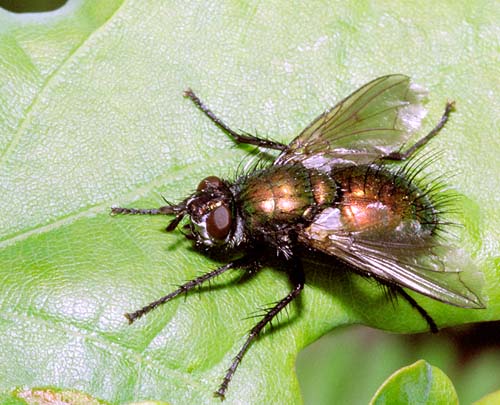Diptera.info :: Identification queries :: Diptera (adults)
|
Tachinidae - Gymnocheta viridis
|
|
| digitalg |
Posted on 07-08-2006 17:04
|
|
Member Location: Portugal Posts: 51 Joined: 31.07.06 |
This one was a large one, about 13-15mm, can't recall it well enought. May 2003, bushes in a pinetree forest but very close to a crop field and between small villages. Center of Portugal. I don't see many of these. digitalg attached the following image:  [51.9Kb] Edited by digitalg on 10-08-2006 10:27 Armando Fraz„o http://bugs.digit... |
| Tony Irwin |
Posted on 08-08-2006 08:29
|
|
Member Location: Norwich, England Posts: 7317 Joined: 19.11.04 |
Hi Armando I'd say this is Gymnocheta viridis. There is a second species of European Gymnocheta, but it doesn't occur in your area. I don't know what the distinguishing characters are. Tony ---------- Tony Irwin |
|
|
|
| crex |
Posted on 08-08-2006 08:52
|
|
Member Location: Sweden Posts: 1996 Joined: 22.05.06 |
I know there are bluebottles and greenbottles. Perhaps this is an orangebottle or a bronzebottle?  ... Anyway it's a cool looking fly. It would be nice in the gallery (if cropped a bit more). ... Anyway it's a cool looking fly. It would be nice in the gallery (if cropped a bit more).
Edited by crex on 08-08-2006 08:57 |
|
|
|
| Tony Irwin |
Posted on 08-08-2006 10:42
|
|
Member Location: Norwich, England Posts: 7317 Joined: 19.11.04 |
Gymnocheta is one of those greenbottles that changes as it gets older, becoming bronze- or copper-coloured. The green coloration is produced by the differential refraction of light from the many-layered cuticle. As the fly ages, particlularly if it spends much time in the sun, the cuticle changes in structure and the wavelength of light that is refracted changes. I'm not sure exactly how the cuticle changes, but when I get my electron microscope .... 
Edited by Tony Irwin on 08-08-2006 10:44 Tony ---------- Tony Irwin |
|
|
|
| Zeegers |
Posted on 08-08-2006 20:28
|
|
Member Location: Soest, NL Posts: 19208 Joined: 21.07.04 |
I agree with Tony, Gymnochaeta viridis, a female. He has already given the best feature to distinguish this one from the second one G. magna: that is both boreo-alpine and very rare. Very similar, it has a little more snout. Females nearly impossible to distinguish. Theo |
|
|
|
| digitalg |
Posted on 10-08-2006 10:33
|
|
Member Location: Portugal Posts: 51 Joined: 31.07.06 |
So ... I have a rare bug!  Wonderfull, I did say I very rarely see things like this ... but then again, It has been about 18 years since I last saw a Lucanus cervus in this place I grew up and the other day I saw one! I don't know why these things make me happy! Also took some shots of it! I'll look into my photo archives and see if I can get a better croping of this image to submit to gallery. Thank you all Edited by digitalg on 10-08-2006 10:34 Armando Fraz„o http://bugs.digit... |
| Tony Irwin |
Posted on 10-08-2006 11:02
|
|
Member Location: Norwich, England Posts: 7317 Joined: 19.11.04 |
This species is not so rare, Armando, but I still get pleasure when I see it (maybe because it's one of the few tachinids I can identify in the field!  ) Whether rare or not, all of these flies are fascinating, and it's great to have a site like this where we can share our pleasure. (I was totally bowled over by Gerard's dolichopodid with the wierd arista this morning! ) Whether rare or not, all of these flies are fascinating, and it's great to have a site like this where we can share our pleasure. (I was totally bowled over by Gerard's dolichopodid with the wierd arista this morning!    ) )
Edited by Tony Irwin on 10-08-2006 11:03 Tony ---------- Tony Irwin |
|
|
|
| digitalg |
Posted on 13-08-2006 17:18
|
|
Member Location: Portugal Posts: 51 Joined: 31.07.06 |
Tony Irwin wrote: Gymnocheta is one of those greenbottles that changes as it gets older, becoming bronze- or copper-coloured. The green coloration is produced by the differential refraction of light from the many-layered cuticle. As the fly ages, particlularly if it spends much time in the sun, the cuticle changes in structure and the wavelength of light that is refracted changes. ... I was think about using this peace of knowledge in the description of the fly at my bugs site, would it be ok by you? I already have a version to the diptera gallery, but it too large a file and I'm not home to reprocess it! maybe tomorrow Thank you Armando Fraz„o http://bugs.digit... |
| Tony Irwin |
Posted on 13-08-2006 17:57
|
|
Member Location: Norwich, England Posts: 7317 Joined: 19.11.04 |
Fine by me Armando - I don't own the information, I just pass it around!  You're welcome to use my wording anyway. 
Tony ---------- Tony Irwin |
|
|
|
| Jump to Forum: |













